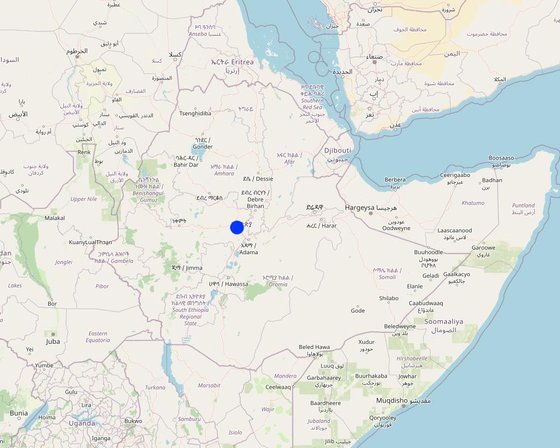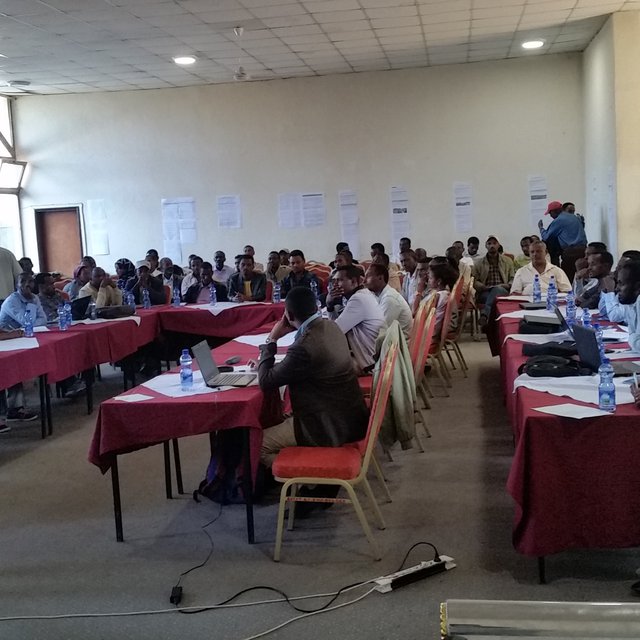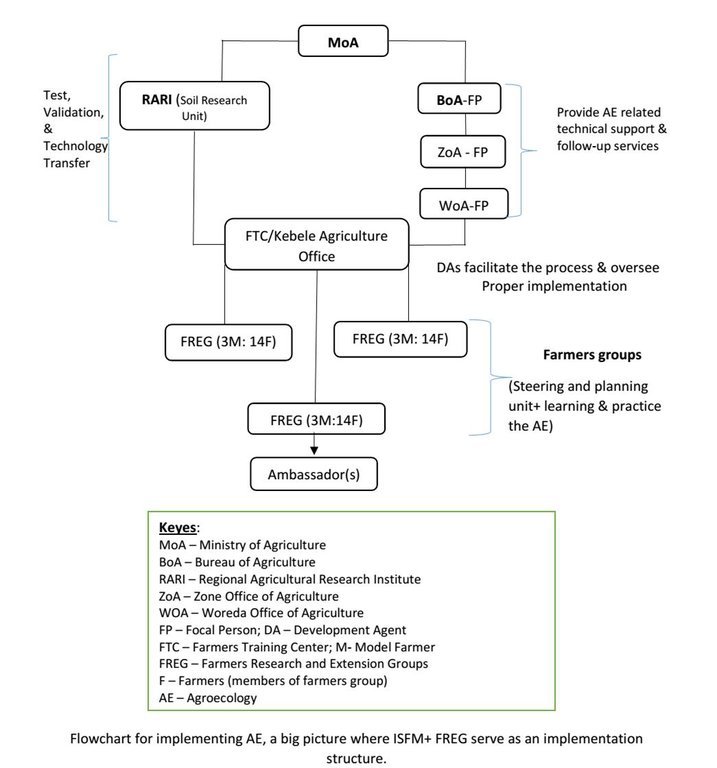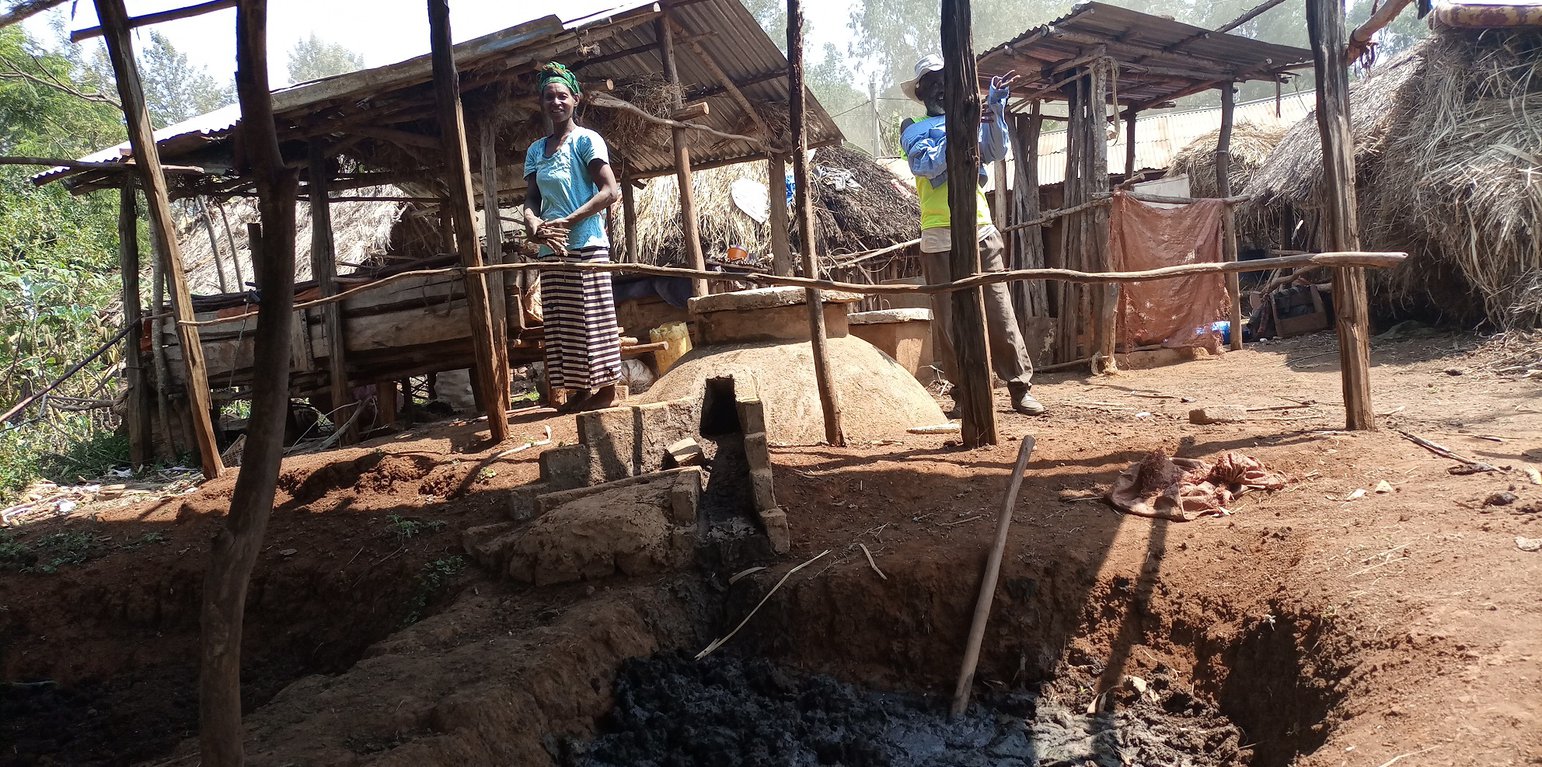Integrated Soil Fertility Management (ISFM)
(أثيوبيا)
Qindoomina Misooma Gabbina Biyyee (Afaan Oromoo) /Yeteqenaje ye Afer Limat (Amharic)
الوصف
The Integrated Soil Fertility Management (ISFM) approach has been adopted under the Integrated Soil Fertility Management Project (ISFM+). It was introduced as a quick-win solution to increase both crop and biomass production through the incremental promotion of varied but complementary technology packages.
The Integrated Soil Fertility Management (ISFM) approach is intended to increase both crop and biomass production through the incremental promotion of varied but complementary technology packages. These include the production and use of organic fertilizers, treatment of soil acidity, and improved retention of crop residue. All help in reducing the depletion (mining) of soil nutrients. One characteristic feature is the engagement of research and development partners at all levels such as in joint problem identification, learning, participatory planning, piloting technology, and exchange visits. The approach involves model farmers and also focuses on farmers with limited means to purchase chemical fertilizers. It enhances the production of organic fertilizers to increase both soil fertility and crop productivity. Furthermore, ISFM enables farmers to generate off-farm and on-farm income through the production and sale of organic fertilizers, vermiworms, and green manure seeds, etc. The partners assist in identifying soil-related issues, as well as enhancing the adoption and institutionalization of the approach. ISFM aims to improve stakeholders' understanding of land degradation issues and the necessity of SLM by creating access to relevant seasonal training, exposure visits, collective learning, and action.
Project focal persons representing partners at different levels and development agents (DAs) are used to facilitate the process and serve as potential links with stakeholders. At the local level, the Farmers Research and Extension Group (FREG) sub-approach supports the implementation of the technologies on an incremental basis (see WOCAT database). Also, the Soil Fertility Improvement Cluster approach (see WOCAT database) assists in scaling out of the ISFM approach by adopting and superimposing technologies such as vermicompost with improved compost production. Farmer ambassadors are identified from the FREG model based on their performance. They assist in mainstreaming and dissemination of the approach and technologies to indirect beneficiaries. The implementation process of the ISFM involves district and kebele selection, identification of watersheds and voluntary farmers, provision of capacity-building training, conducting participatory planning, supplying inputs, and technical support. To realize the aims, the ISFM+ allocates financial support to the partners at different levels via Local Subsidy Contract.
Project staff including federal and regional advisors are involved. They provide training, technical backstopping, reviewing progress, M&E, and feedback services. District focal person closely follows up on the implementation - with the support of DAs in steering farmers' group meetings and collective learning. In addition, DAs assist in piloting on farm short and long-term demonstrations, organizing field days and exchange visits, collecting data, and overseeing activities.
Land users like the technologies introduced and implemented via the ISFM approach. The promotion of collective learning and action leads to increased soil fertility, and improved crop production and smallholders' livelihoods. The creation of new sources of income for land users is among the benefits they appreciate the most. However, farmers are less enthusiastic by the way that group meetings clash with their other activities and this leads to some members dropping out. Also, the cost of technologies promoted by the ISFM such as combined uses of chemical fertilizers, bio-fertilizers (for legumes), organic fertilizers, and quality seeds are envisaged as a possible constraint among others.
الموقع

الموقع: Addis Ababa, أثيوبيا
المرجع الجغرافي للمواقع المختارة
تاريخ البدء: 2015
سنة الإنهاء: 2025
نوع النهج
-
تقليدي/أصلي
-
مبادرة محلية حديثة/مبتكرة
-
قائم على مشروع/برنامج

ISFM+ focal persons and other member of the development partners progress assessment and planning meeting. (Gerba Leta)
غايات النهج والبيئة المواتية
الغايات/الأهداف الرئيسية للنهج
The main objective of the approach is to promote the integration of technologies, collective learning, and action for treating degraded soil, increasing soil fertility and crop productivity while ensuring sustainable uses of land.
الشروط التي تمكن من تنفيذ التقنية/التقنيات المطبقة في إطار النهج
-
توفر/الوصول إلى الموارد والخدمات المالية: Access to financial resources improved farmers' access to materials and inputs on their own. This promotes the adoption and scaling up of the technology using ISFM approach.
-
الإطار المؤسساتي: Institutional setting such as farmers' group formation promotes collective learning and action.
-
التعاون/التنسيق بين الجهات الفاعلة: Is central to promoting effective implementation of the approach that entails various research and development actors.
-
السياسات: Such as adopting lime production, distribution and use policy enables successful implementation of the approach.
-
عبء العمل، توفر القوى العاملة: Family labor enables production of organic fertilizers and effective implementation of lime and other technologies which are labor intensive.
الظروف التي تعيق تنفيذ التقنية/التقنيات المطبقة في إطار النهج
مشاركة وأدوار الأطراف المعنية
الأطراف المعنية بالنهج وأدوارها
| ما هي الجهات المعنية / الكيانات المنفذة التي شاركت في النهج؟ |
حدد الأطراف المعنيين |
وصف أدوار الأطراف المعنية |
| مستخدمو الأراضي المحليون/المجتمعات المحلية |
Model farmers, and other smallholders (followers). |
Lead group meeting, facilitate collective learning and action based on the pilot practices/activities. |
| متخصصون في الإدارة المستدامة للأراضي / مستشارون زراعيون |
Focal persons and experts from soil fertility improvement /extension unit of the district. |
Facilitate implementation of the technology via the approach, and serve as a link between stakeholders. |
| الباحثون |
Soil researchers from Regional Research Institutes, and respective technologies. |
Soil testing, production of bio fertilizer, and supporting the different technologies with research findings. |
| منظمة غير حكومية |
SNV Ethiopia, Nutrition Sensitive Agriculture, and other GIZ projects. |
Integration of efforts such as on biogas/bioslurry production and other respective project implementation activities. |
| القطاع الخاص |
Agro dealers, and other services providers |
Facilitate the distribution of lime and improved seeds, provide services on mechanization such as maintenance, etc. |
| الحكومة المحلية |
District office of agriculture, and woreda administration. |
Partnerships, acknowledge implementation of the project and provide administrative support when required. |
| الحكومة الوطنية (المخططون، صانعو القرار) |
Ministry of Agriculture and Research System. |
Support in mainstreaming the technology and approach, policy formulation and research support testing soil and tools... |
| منظمة دولية |
CIAT, CIMMYT, ICRISAT... |
Provide research and technical support in joint areas of intervention. |
الوكالة الرائدة
Integrated Soil Fertility Management Project (ISFM+).
انخراط مستخدمي الأراضي المحليين/المجتمعات المحلية في المراحل المختلفة للنهج
غير موجود
سلبي
الدعم الخارجي
تفاعلي
التعبئة الذاتية
المبادرة/التحفيز
District focal person and development agents. Facilitate the implementation right from awareness raising, farmers' group formation, training, supply inputs, and technically support the implementation.
التخطيط
Regional advisor, focal persons, and the farmers. Each engaged in a participatory planning exercise.
التنفيذ
Farmers, focal persons, and development agents. Farmers implement the technologies being guided by the approach. Whereas, the focal person and development agents oversee and provide technical support.
الرصد/التقييم
Focal person, development agents, and land users. They conduct participatory M&E to ensure collective learning.
مخطط التدفق
ISFM approach that run from the federal to kebele where FREG is the pillar approach serving the land users as a platform for collective learning and action at local level.

المؤلف: Gerba Leta
اتخاذ القرار بشأن اختيار تقنية الإدارة المستدامة للأراضي
وقد تم اتخاذ القرارات من قبل
-
مستخدمو الأراضي وحدهم (المبادرة الذاتية)
-
مستخدمو الأراضي بشكل أساسي، بدعم من متخصصي الإدارة المستدامة للأراضي
-
جميع الجهات الفاعلة ذات الصلة، كجزء من نهج تشاركي
-
متخصصون في الإدارة المستدامة للأراضي بشكل أساسي، بعد التشاور مع مستخدمي الأراضي
-
متخصصون في الإدارة المستدامة للأراضي بمفردهم
-
السياسيون / القادة
تم اتخاذ القرارات بناء على
-
تقييم المعرفة الموثقة جيدًا بشأن الإدارة المستدامة للأراضي(اتخاذ القرارات القائمة على الأدلة)
-
نتائج البحوث
-
خبرة وآراء شخصية(غير موثقة)
الدعم الفني وبناء القدرات وإدارة المعرفة
شكلت الأنشطة أو الخدمات التالية جزءًا من النهج
-
بناء القدرات/التدريب
-
خدمة استشارية
-
تعزيز المؤسسات (التطوير التنظيمي)
-
الرصد والتقييم
-
البحوث
بناء القدرات/التدريب
تم تقديم التدريب للأطراف المعنية التالية
-
مستخدمو الأراضي
-
موظفون ميدانيون/ مستشارون
شكل التدريب
-
في العمل
-
من مزارع إلى مزارع
-
مناطق العرض
-
اجتماعات عامة
-
دورات
المواضيع المغطاة
Soil degradation, rehabilitation of the degraded soil using different technologies and agronomic practices notably lime, organic fertilizers, bio fertilizer, crop residue management, mixed cropping, green manuring, application of minimum tillage practices, etc.
خدمة استشارية
تم تقديم الخدمة الاستشارية
-
في حقول مستخدمي الأراضي
-
في مراكز دائمة
Advisory services are provided by the focal person and development agents at Farmers Training Center and on the farmers' field.
تعزيز المؤسسات
تم تعزيز/إنشاء المؤسسات
-
لا
-
نعم، قليلا
-
نعم، باعتدال
-
نعم، إلى حد كبير
صف المؤسسة والأدوار والمسؤوليات والأعضاء وما إلى ذلك.
Farmers Research and Extension Group (FREG) has been established at the local level and has been serving as an approach at the local level. It has been serving as a local platform that brings members of the farmers' group together in participatory planning and joint learning of the technologies piloted on the farmer's field and short and long-term demonstrations.
نوع الدعم
-
مالي
-
بناء القدرات/التدريب
-
معدات
مزيد من التفاصيل
The project provides financial support through the Local Subsidy Contract. Capacity building is central to the implementation of the project. Farm tools as an incentive for the best-performing farmers and on-field soil testing equipment are provided to support the partner organizations scaling out the implementation of ISFM.
الرصد والتقييم
Monitoring and evaluation is the pillar of the project activities and the adopted approach. The project along with implementing partners pilot short-term and long-term demonstrations, monitor the progress, and evaluate the achievements. Therefore, M&E is a regular activity in which the federal and regional project advisors rely on to generate feedbacks to amend or improve the implementation of the project activities.
البحوث
تناول البحث المواضيع التالية
-
علم الاجتماع
-
الاقتصاد / التسويق
-
علم الايكولوجيا
-
تكنولوجيا
The research targets the feasibility of the technologies introduced via the ISFM approach and the project itself. The role of integrating different technology packages in improving soil fertility and crop productivity is also among the focuses of the research.
التمويل والدعم المادي الخارجي
الميزانية السنوية بالدولار الأمريكي لمكون الإدارة المستدامة للأراضي
-
< 2000
-
10,0000-2,000
-
100,000-10,000
-
1,000000-100،000
-
> 1,000,000
Precise annual budget: غير متاح
ISFM+ is the source of the budget. A local Subsidy Contract (LSC) has been provided to partner organizations to effectively implement and follow up the activities with an additional allocation of finance for inputs and services.
تم تقديم الخدمات أو الحوافز التالية لمستخدمي الأراضي
-
الدعم المالي/المادي المقدم لمستخدمي الأراضي
-
إعانات لمدخلات محددة
-
الائتمان
-
حوافز أو وسائل أخرى
الدعم المالي/المادي المقدم لمستخدمي الأراضي
The project introduces technologies, provides inputs (improved seeds, chemical fertilizers, lime), and seldom supplies farm tools for a few well-performing models as an incentive.
حوافز أو وسائل أخرى
Farm tools for outstanding farmers as well as a solar panel for residents in a rural setting as an incentive for well-performing in adopting the approach and proper implementation of the project.
تحليل الأثر والتصريحات الختامية
آثار النهج
لا
نعم، قليلا
نعم، باعتدال
نعم، إلى حد كبير
هل ساهم النهج في تمكين مستخدمي الأراضي المحليين وتحسين مشاركة الأطراف المعنية؟
Land users learned the benefit of integrating three or more technologies/practices to improve soil fertility, and crop productivity and ensure the SLM is being in place.
هل مكّن النهج من اتخاذ القرارات المبنية على الأدلة؟
The approach certainly enables evidence-based decision-making by comparing the yield from the plots with treatment (technology packages) versus the control (without full packages).
هل ساعد النهج مستخدمي الأراضي على تنفيذ وصيانة تقنيات الإدارة المستدامة للأراضي؟
The combination of three or more technologies, all in one inspires the land users to adopt and sustainably implement the SLM technologies.
هل نجح النهج في تحسين التنسيق والتنفيذ الفعال من حيث التكلفة لأنشطة الإدارة المستدامة للأراضي؟
Coordination at a local level is not up to the expectation.
هل نجح النهج في تعبئة/تحسين الوصول إلى الموارد المالية لتنفيذ الإدارة المستدامة للأراضي؟
هل أدى النهج إلى تحسين معرفة وقدرات مستخدمي الأراضي على تنفيذ الإدارة المستدامة للأراضي؟
It improves the knowledge and skills of land users to implement SLM by promoting collective learning and action that highly increases peer learning through observation and social learning.
هل أدى النهج إلى تحسين معرفة وقدرات الأطراف المعنية الأخرى؟
It impacts or improves the knowledge and skills of indirect beneficiaries through farmer's ambassadors.
هل ساهم النهج في بناء/تعزيز المؤسسات والتعاون بين الأطراف المعنية؟
It strengthens the inter-farmers collaboration and coordination that is seldom constrained by the overlaps with local activities such as public meetings and other communal affairs mostly known as new arrivals.
هل ساهم النهج في التخفيف من حدة الصراعات؟
هل ساهم النهج في تمكين الفئات المحرومة اجتماعيا واقتصاديا؟
Farmers who have no financial means to access and use chemical fertilizers and other inputs involved via the approach.
هل أدى النهج إلى تحسين المساواة بين الجنسين وتمكين النساء والفتيات؟
One-third of a member of the farmers' group are women farmers- a signal for improvement of participation by gender.
هل شجع النهج الشباب/الجيل القادم من مستخدمي الأراضي على الانخراط في الإدارة المستدامة للأراضي؟
There is an assumption that young people learn from the family and neighbors who engaged in the implementation of the approach. This certainly inspires the young generation to take up and implement SLM activities.
هل أدى النهج إلى تحسن في مسائل حيازة الأراضي / حقوق المستخدمين التي أعاقت تنفيذ تقنيات الإدارة المستدامة للأراضي؟
هل أدى هذا النهج إلى تحسين الأمن الغذائي / تحسين التغذية؟
Through promoting technologies/practices that improve production and productivity. By promoting legumes crop production using biofertilizers and as part of intercropping practices that ensure the nutrition security of the family farmers.
هل أدى النهج إلى تحسين الوصول إلى الأسواق؟
It improves participants' access to the inputs market (selling organic fertilizers, green manure seeds, vermiworms, and surplus products).
هل أدى النهج إلى تحسين الوصول إلى المياه والصرف الصحي؟
هل أدى النهج إلى استخدام طاقة/ مصادر طاقة أكثر استدامة؟
Mainly through supporting biogas/bioslurry technology, and the introduction of woodlots to family farmers via agroecology projects that adopt a similar approach.
هل أدى النهج إلى تحسين قدرة مستخدمي الأراضي على التكيف مع التغيرات المناخية/الظواهر المناخية المتطرفة والتخفيف من الكوارث المرتبطة بالمناخ؟
This is partly through adopting minimum tillage practices, crop residue management, and the production and use of organic fertilizers that reduce carbon emissions and foster carbon sequestration.
هل أدى النهج إلى توفير فرص عمل ودخل؟
It creates income opportunities by promoting surplus production, production, and sale of organic fertilizers, vermiworms, and green manure seeds.
المحفز الرئيسي لقيام مستخدمي الأراضي بتنفيذ الإدارة المستدامة للأراضي
-
زيادة الإنتاج
-
زيادة الربح (القدرة)، وتحسين نسبة التكلفة إلى العائد
-
الحد من تدهور الأراضي
-
الحد من مخاطر الكوارث
-
انخفاض عبء العمل
-
المدفوعات/ الإعانات
-
القواعد واللوائح (الغرامات) / الإنفاذ
-
الوجاهة والضغط الاجتماعي/التماسك الاجتماعي
-
الانتماء إلى حركة/ مشروع/ مجموعة/ شبكات
-
الوعي البيئي
-
العادات والمعتقدات والأخلاق
-
تعزيز المعرفة والمهارات في مجال الإدارة المستدامة للأراضي
-
تحسينات جماليية
-
التخفيف من حدة الصراع
استدامة أنشطة النهج
هل يمكن لمستخدمي الأراضي الحفاظ على استدامة ما تم تنفيذه من خلال النهج (بدون دعم خارجي)؟
As the production of organic fertilizers adopted on an individual basis and tangible benefit acquired from the implementation of the integrated approach introduced via the approach as well as the increasingly growing supply of lime for acid soil amendments similar to other chemical fertilizers, the likelihood of sustaining the approach for implementing integrated technologies is inevitable. Besides, the public organizations for instance bureaus of Agriculture and line offices such as in west Oromia of Jimma and Buno-Bedele zones institutionalized the production and uses of organic fertilizers via huge investments in establishing vermiculture centers to reach out to the large majority of smallholders subjected to soil degradation issues.
الاستنتاجات والدروس المستفادة
نقاط القوة: وجهة نظر مستخدم الأرض
-
It promotes collective learning and action among smallholders living in a homogenous landscape facing similar land/soil degradation issues.
-
It enhances soil fertility and soil health by introducing integrated technologies and creating evidence-based learning.
-
Gain widespread publicity that allows the public and land users to build trust in the approach and component technologies that positively impact the livelihood of smallholders and the land in general.
نقاط القوة: وجهة نظر جامع المعلومات أو غيره من الأشخاص الرئيسيين لمصدر المعلومات
-
The approach has been adopted and institutionalized within the government's mainstream rural development and agricultural extension.
-
The project and the implementation approach are in line with the government's short and long-term plan to ensure the food and nutrition security of the nations while conserving natural resource basis.
-
Integration is basic to address the nexus of issues that combine knowledge and skills development, the introduction of important agricultural inputs, technologies, or practices, all in one.
نقاط الضعف / المساوىء / المخاطر: وجهة نظر مستخدم الأرضكيفية التغلب عليها
-
Integrating technologies/practices and inputs via the approach has cost implications.
Promote the land user's awareness of the cost-benefit of adopting the approach and introduction of subsidy to some inputs such as agriculture lime for acid soil amendments.
-
The approach drives labor-demanding technologies and practices.
Promote collective action through adopting labor share arrangements as well as efficiently use family labor for follow-up of the production of organic fertilizers by task sharing.
-
The high investment cost for some technologies is promoted by the approach.
Enable land users to make the right choices of diverse technologies catered through the project and the adopted approach.
-
Delay in supply of agricultural inputs such as agricultural lime
Encourage private sectors involvement or the agro dealers in the supply of the agricultural inputs.
نقاط الضعف / المساوىء / المخاطر: وجهة نظر جامع المعلومات أو غيره من الأشخاص الرئيسيين لمصدر المعلوماتكيفية التغلب عليها
-
The limited scope of the project implementation sites.
To try to reach out to similar landscapes with similar land degradation issues including the marginal regions. Or else, institutionalize the approach at the national level so that the public sector takes up and popularizes it in areas with similar problems.
-
The collaboration and collective action at local levels through the existing platform is staggered by new arrivals and other local administrative chores.
Local government actors and partners need to be well aware and give due emphasis beyond considering the intervention implemented through ISFM as merely project activities that usually come and go.
المراجع
المحررون
-
Noel Templer
-
Julia Doldt
-
Torben Helbig
-
Tabitha Nekesa
-
Ahmadou Gaye
-
Siagbé Golli
المُراجع
-
William Critchley
-
Rima Mekdaschi Studer
-
Sally Bunning
تاريخ التوثيق: 19 إبريل، 2023
اخر تحديث: 26 إبريل، 2024
الأشخاص الرئيسيين لمصدر المعلومات
-
Torben Helbig (torben.helbig@giz.de) - متخصص في الإدارة المستدامة للأراضي
الوصف الكامل في قاعدة بيانات WOCAT
بيانات الإدارة المستدامة للأراضي المرتبطة
تم تسهيل التوثيق من قِبَل
المؤسسة
- Alliance Bioversity and International Center for Tropical Agriculture (Alliance Bioversity-CIAT) - كينيا
المشروع
- Soil protection and rehabilitation for food security (ProSo(i)l)
المراجع الرئيسية
-
Leta, G., Schulz, S., Alemu, G. 2020. Agricultural extension approach: evidence from an Integrated Soil Fertility Management project in Ethiopia. Frontiers of Agricultural Science and Engineering, 7(4): 1-13. DOI: 10.15302/J-FASE-2020331: Free online
روابط للمعلومات ذات الصلة المتوفرة على الإنترنت






